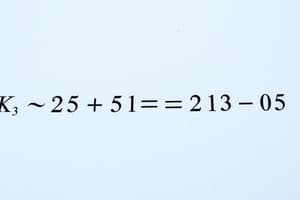Podcast
Questions and Answers
What category of errors arise during the measurement process?
What category of errors arise during the measurement process?
- Systematic Errors (correct)
- Random Errors
- Human Errors
- Gross Errors
What is the main difference between Gross Errors and Systematic Errors?
What is the main difference between Gross Errors and Systematic Errors?
- Gross Errors are avoidable, while Systematic Errors are unavoidable.
- Gross Errors are periodic, while Systematic Errors are constant.
- Gross Errors are due to instruments, while Systematic Errors are due to humans.
- Gross Errors are human mistakes, while Systematic Errors are instrument errors. (correct)
What are the three groups of errors that can occur during the measurement process?
What are the three groups of errors that can occur during the measurement process?
- Instrumental, Human, and Environmental Errors
- Gross, Systematic, and Human Errors
- Random, Systematic, and Instrumental Errors
- Gross, Systematic, and Random Errors (correct)
Which type of error is due to a fault in the measurement instrument?
Which type of error is due to a fault in the measurement instrument?
What type of error is avoidable?
What type of error is avoidable?
What is the primary concern in minimizing errors?
What is the primary concern in minimizing errors?
According to the content, what is the best way to minimize gross errors?
According to the content, what is the best way to minimize gross errors?
What is the main implication of gross errors?
What is the main implication of gross errors?
What is the advised approach to dealing with gross errors?
What is the advised approach to dealing with gross errors?
What is the nature of gross errors?
What is the nature of gross errors?
What is the primary advantage of taking multiple readings by different observers?
What is the primary advantage of taking multiple readings by different observers?
What is the purpose of statistical analysis in the measurement process?
What is the purpose of statistical analysis in the measurement process?
What is the expected outcome of following the two-step process of measurement?
What is the expected outcome of following the two-step process of measurement?
What is the role of the observers in the measurement process?
What is the role of the observers in the measurement process?
What is the underlying assumption in taking multiple readings?
What is the underlying assumption in taking multiple readings?
What happens to ❑𝝈 as the number of measurements increases?
What happens to ❑𝝈 as the number of measurements increases?
What is the relationship between the number of measurements and confidence in the mean value?
What is the relationship between the number of measurements and confidence in the mean value?
What can be inferred from the decrease in ❑𝝈 as the number of measurements increases?
What can be inferred from the decrease in ❑𝝈 as the number of measurements increases?
What is the effect of increasing the number of measurements on the mean value?
What is the effect of increasing the number of measurements on the mean value?
What is the implication of ❑𝝈 decreasing as the number of measurements increases?
What is the implication of ❑𝝈 decreasing as the number of measurements increases?
What is the purpose of the formula m = (x1 + x2 + x3 + ......+ xN) / N?
What is the purpose of the formula m = (x1 + x2 + x3 + ......+ xN) / N?
What is the variable N in the formula m = (x1 + x2 + x3 + ......+ xN) / N?
What is the variable N in the formula m = (x1 + x2 + x3 + ......+ xN) / N?
What is the result of the formula m = (x1 + x2 + x3 + ......+ xN) / N if all the readings are equal?
What is the result of the formula m = (x1 + x2 + x3 + ......+ xN) / N if all the readings are equal?
What operation is performed first in the formula m = (x1 + x2 + x3 + ......+ xN) / N?
What operation is performed first in the formula m = (x1 + x2 + x3 + ......+ xN) / N?
What is the assumption behind the formula m = (x1 + x2 + x3 + ......+ xN) / N?
What is the assumption behind the formula m = (x1 + x2 + x3 + ......+ xN) / N?
Flashcards are hidden until you start studying
Study Notes
Types of Measurement Errors
- Errors during the measurement process can be divided into three groups: Gross Errors, Systematic Errors, and another type (not specified).
Gross Errors (Human Error)
- Gross errors are caused by human mistakes and cannot be eliminated, but they can be minimized.
- To minimize gross errors, follow these steps:
- Note down readings carefully.
- Another step to minimize gross errors (not specified).
How to Get Accurate Measurements
- To get accurate measurements, follow a two-step process:
- Step 1: Take multiple readings by different observers.
- Step 2: Perform statistical analysis on the readings obtained in Step 1.
- The mean or average value of these readings can be calculated using the formula: m = (x1 + x2 + x3 + … + xN) / N.
- As the number of measurements increases, Dr. σ (standard deviation) gets smaller, increasing confidence in the mean value.
Studying That Suits You
Use AI to generate personalized quizzes and flashcards to suit your learning preferences.




